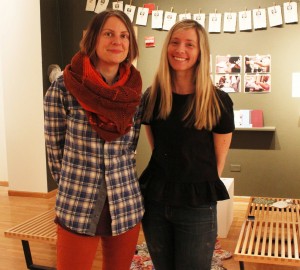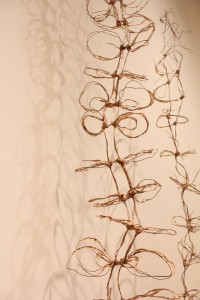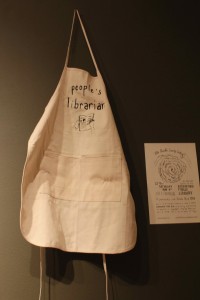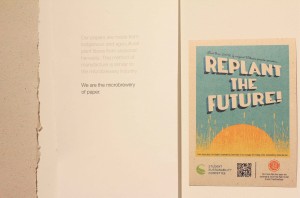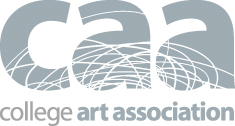What is the conversation between socially engaged community craft and gallery art? How can we understand these two seemingly conflicting forms in our current social and cultural landscapes? These are some of the questions that I am talking about with Mel Potter, co-curator of Social Paper and panelist for Friday’s “From Paper to Practice: Tactics and Publics in Socially Engaged Art”.
Before she arrives for our interview, co-curator Jessica Cochran shows me around the gallery which is filled with everything from paper artifacts from Alison Knowles to Combat Paper to an exhibition by the People’s Library. It is abundantly clear that the works curated into this gallery each place paper and paper making within a larger cultural, ecological, and artistic conversation.
Julynn Wilderson: Where did Social Paper start as an idea?
Mel Potter: Well, Jessica and I have been working on it for about two years now, and it came out of some really interesting conversations around the idea that hand paper makers have actually been doing socially engaged art without the benefit of the discourse for thirty or more years. At this point and the City of Chicago is going through what Mary Jane Jacobs at SAIC called the Year of Social Practice. So this show really sits in this kind of larger discussion with RISK and Arts Incubator, and the open engagement conference over at MCA. So the show is really about contextualizing hand paper making within current discourse of socially engaged art, which actually has not been done before. The project has received a grant form the Center for Craft, Creativity and Design to create a catalogue and create a lot of new discourse around this intersection.
JW: I’m glad you mention that because my next question was going to be, where do you see the intersection of craft, the gallery, and social practice?
MP: So, this is my perspective as a teacher, which sort of raises the ideas of creative pedagogy. About three or four years ago, I designed a class called “The History of Paper,” and it’s one of the classes we have [that can fulfill the] history requirement for our students, and it really sort of evaluated hand papermaking within this distinctive American tradition of radical culture that happened as a response to the Industrial Revolution at the end of the 1800s and early 1900s. Within that context, a few years ago I really started engaging with ideas and pedagogy and craft movements of the Jane Addams Hull-House which really sits in a country wide worker empowerment movement. A number of places across the country, Penland School of Crafts, Jane Adams Hull House, Greenwich House Pottery, Henry Street Settlement, there were these settlement houses basically help these people use the craft arts to get in touch with their native heritage, but also think about micro industry and oer ways that they could make money for their families. Ultimately Jane Addams believed that it made us all better global citizens, so she had this very large radical idea about how craft could transform us all into more responsible individuals, into people who understood the value of each individual’s labor. So it really sort of comes from this deeply radical place and over the course of a hundred years, the movements in craft kind of got generated and developed as Artist Access Studios and today we have this whole concept of DIY and radical craft—actually radical craft is not a widely used concept but Jessica and I are incorporating it a lot into the writing that we’re doing. But, the whole DIY movement really owes its roots to the turn of the century movement I just described, and I think it’s very important historically that people understand that that really is the vibe of our whole society and culture, the relationship between fine art and craft and industry are interwoven in a totally unique way in the United States.
JW: What is the conversation with these radical empowerment movements that are coming through local craft communities and an understanding of how it is present in a global community?
MP: I would kind of say that Jessica and I kind of but off two huge things to chew. One is social practice, which is an evolving discourse that needs a lot of work, and there is still a lot of snobbism and weirdness around this idea of the intersection of pedagogies and radical culture and art, so you’ve got that whole issue. Which is enough work in and of itself. Then you’ve got hand papermaking, which is a largely unknown craft, art, fine art, and trying to contextualize that within a contemporary artistic framework. So I think social practice, I mean if you look at the trends in education nationally, social practice is clearly on the rise. The Otis School with Suzanne Lacy has her public practice program, there are a lot of programs bubbling up. And I think it’s that with every action there is an equal and opposite reaction. You’ve had the rise of capital, the dot-com boom, of course there’s going to be a movement that responds that is much more about homesteading and the home base and the things we can produce ourselves, locally. So I think that the artistic discourse is sitting within the larger cultural discourse, as it always does: a radical reaction to neo-liberalism, to late market capitalism, to the exploits of globalization. I think that everybody, somewhere in their subconscious, or at least in their public conscience of how the world is going, can feel the discourse within social practice and understand that it actually is a response to elite cultures of capital. I think the whole city is also part of this larger discourse.
What we’re really hoping to accomplish with this show is to recontextualize hand paper making as a serious medium with a very serious and long and undocumented history of radical culture. And that’s kind of our dream for the show.
JW: It’s very exciting how you use the craft as well as actively combatting this kind of global capitalism which outsources particular labors in order to create “your” art. Like for example, paper that uses local fibers that eventually would become waste…
MP: They have different contexts when you are talking about crafts in local communities. These are usually the silenced and generally oppressed… the people who are oppressed and affected by global capitalism, the women, children, developing world countries, and so a lot of the projects in this show invoke localism in the sense that a lot of the fibers are locally available but they also invoke this idea of shared experience.
For instance, with Nick DuBois’ project in Palestine people brought objects that were infused with a lot of pain and suffering and ideas around how they wanted to be remembered and worked with people across the table who in some cases present a direct political threat or direct social threat to them, and combine these ideas and artworks that embodied their individual experiences.
I think in the art world we have this idea that everything has to be permanent and have longevity. Yes, many of these objects are beautiful art objects, but I think that social practice is also very much about the experience and the experiential and that something transformative and important happens at the moment of inception. Something happens when somebody is able to make something of their own, and say something of their own. And it’s much bigger than all of us realize, it’s not that the ephemera is just a very small part of how these things can be transformative.
Papermaking has a very interesting relationship to that because, number one, it’s a fairly simple medium. You can do paper within an afternoon, it’s something that’s within your powers as an individual to pull a sheet of paper and make something with it. In that way it’s a communication tool, a language that’s easily accessible, and I think a lot of the projects in the show relate to paper in that aspect as well. Many of the projects in the show also relate to paper as a local craft that has been poorly recorded but very deeply involved in the cultural landscape. For instance, Trisha Martin’s project in the Philippines. Paper making is a deep, deep part of that culture, it’s a part of their long tradition. Laura Anderson Barbata’s project also invokes papermaking in its traditional form. Cathy Moosses is also the same thing. These are cultures that have deep roots in the paper making movement as art objects, as language producers, as fetish objects and art objects.
JW: As a curator and a craft maker, how do you understand the impulse on one hand to archive and on the other, to value the moment of creation and community making that you cannot archive?
MP: Well, I think this is one of the fundamental conundrums in social practice. As a culture, we value objects because in the art world the object is what’s for sale. And it’s also the thing, as Westerners, that we believe has longevity. Of course these are totally at odds with other cultural ideas of impermanence and the present.
Social Paper is not jut hand papermaking and its relationship to social practice. I think Jessica and I worked really hard to gather a variety of projects that were about the moment and to describe them appropriately, and then others are very much about the object. Julia Goodman’s work is very much about the final object. Fresh Press, very much about the object. And it’s not that any of these projects are not about their final product, it’s just that responsibly, if you’re going to talk about social practice and its relationship to the contemporary art world, it has a lot of hallmarks that go unrecognized and unnoticed, that I think it’s our responsibility to kind of tease out and think more clearly about.
JW: What are some highlights in this exhibition that you are particularly looking forward to?
MP: It’s really hard for me because this is the first show of its kind, so it’s really hard for me to play favorites. Every single project in this show was curated in to reflect a vision and a representation that, as you mentioned earlier, will be kind of the first archive of socially engaged hand papermaking projects. These projects have been written about in various places, but to bring them together… I consider each one really pivotal.
There are themes that arch, research as social practice, ethnography as social practice, creative pedagogy as social practice, art practice, art therapy, microindustry, so there are a bunch of governing ideas around the different projects. Those are my passions, that these new works fit within this language that we’re trying to create about the intersections. I feel very tenderly towards all of this work, too, because this has been a project that took a long time to put together.
Late last night we were working on the tags for the show, and you know I think Jessica and I both feel such a responsibility to describe these projects in their entirety and to give a variety of avenues for people to reflect on what it is that’s happening with the art work. And of course that’s a big challenge and I don’t think any curator totally pulls that off. In film, there’s this thing, you want people to leave wanting more, and I think that that’s a going principle of everything. You want people to be curious enough to walk out and say, ‘you know, this is really something I never thought about before, and I want to know more.’ And I think social practice is asking us to think that way in the art world right now, and I think the hand papermaking movement, with this profound place founded by two women, Marilyn Sward and Barbara Metz, who follow in the footsteps of that radical culture and that space that was made for craft arts in America, that this project invokes that spirit and invokes those ideas around those changed cultures and creates spaces where more voices are heard and more practices are possible, and more ways of communicating are made necessary.
JW: It is very exciting to be blowing the space open for a different vision of what democratic art practice is.
MP: I have this saying that I use a lot, “weird wins the day,” but what I really mean by that is that people on the margins are the ones who are actually influencing the long term status quo discourse, and its our job as artists and curators and purveyors of these weird craft arts, to really think about what it is that they’re doing to change the status quo. What is it that they’re contributing to the ways that we communicate as a culture because after all, at the end of the day, that’s what art is, it’s a form of communication with our culture, with each other, with what it means to be human, what it means to interpret the world. And these media have that power, I believe in the power of these media that way.
What is the conversation between socially engaged community craft and gallery art? How can we understand these two seemingly conflicting forms in our current social and cultural landscapes? These are …

